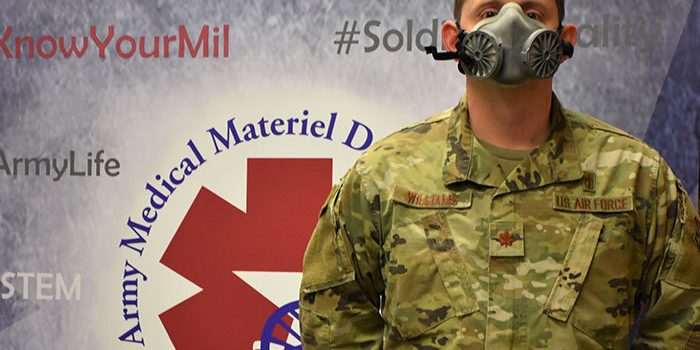In response to the COVID-19 pandemic, the U.S. Army Medical Materiel Development Activity’s (USAMMDA’s) Warfighter Expeditionary Medicine and Treatment Project Management Office (WEMT PMO), as part of the U.S. Army Medical Research and Development Command’s Additive Manufacturing Working Group, has played an integral role in the ramped-up effort to produce N95 respirators for healthcare and frontline workers across the nation.
As stated on the Food and Drug Administration’s website, an N95 respirator is “a respiratory protective device designed to achieve a very close facial fit and very efficient filtration of airborne particles.” Compared to a surgical mask, which is loose fitting, the edges of the N95 mask are designed to form a very tight seal around the individual’s nose and mouth, providing the highest levels of protection against infection from COVID-19.
Air Force Maj. Daniel Williams serves as product manager of the WEMT PMO’s N95 respirator efforts at USAMMDA. These include coordinating programmatic and regulatory support, leveraging existing government resources, and developing synergies within the Defense Department’s organic industrial base to successfully generate N95 respirator products. He explained that his primary task is to ensure the medical device meets military needs and regulatory requirements and that development of the product remains on schedule and within budget.
In a recent interview, Williams offered a great deal of insight with regard to USAMMDA’s N95 respirator efforts and the work to produce and distribute these products as quickly as possible in the battle against the spread of COVID-19 throughout our nation and the world.
As product manager within the WEMT PMO, please describe your responsibilities in regard to the N95 respirator effort.
The N95 effort is a slightly atypical experience in that we are primarily working with DoD partners who have never manufactured medical devices. However, they have extensive experience in various methods of manufacturing, including additive manufacturing, also known as three-dimensional, or 3-D printing. So, our primary responsibility is assisting these DoD manufacturers in navigating the medical device world, including compliance with U.S. Food and Drug Administration and National Institute for Occupational Safety and Health regulations. Further, we facilitate test and evaluation of their products by leveraging DoD laboratories and government partners to obtain performance feedback on respirator prototypes.


